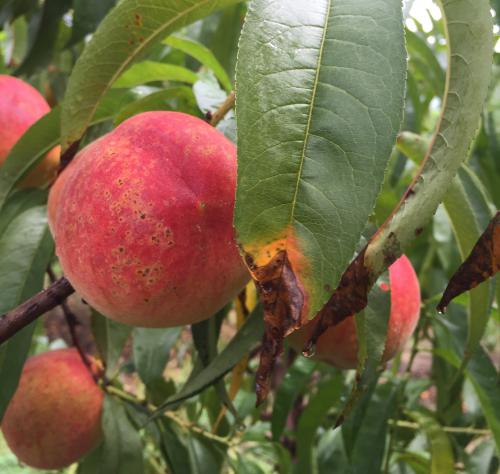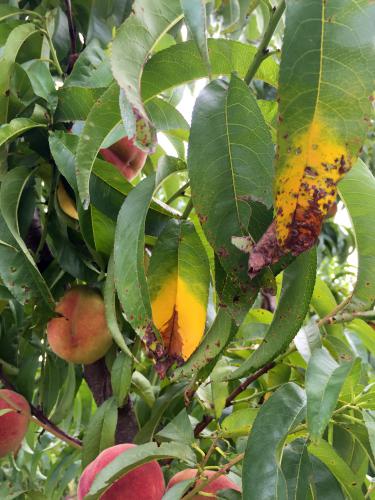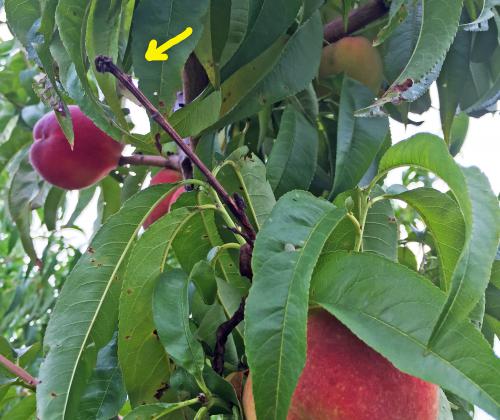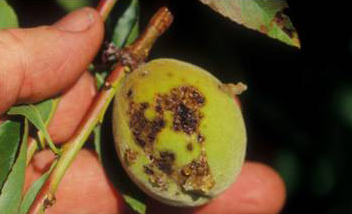Bacterial spot of peach and plum
by William Shane, Michigan State University Extension
March 18, 2018
Impact of bacterial spot
Bacterial spot is an important disease of peaches, nectarines, apricots, and plums caused by Xanthomonas arboricola pv. pruni (XAP), formerly Xanthomonas campestris pv. pruni. The disease’s symptoms include fruit spots, leaf spots and twig cankers.

Leaf tip yellowing and flecked fruit due to bacterial spot. (All photos: William Shane, MSU Extension)

Leaf yellowing and shot holes due to bacterial spot, with relatively clean fruit.
Fruit symptoms include pitting, cracking, gumming and watersoaked tissue. Fruit infected by bacterial spot are more susceptible to other fruit diseases such as brown rot and rhizopus, as well as infestations by insects. Severe leaf spot infections can cause early defoliation. Severe defoliation can result in reduced fruit size, and sunburn and cracking of fruit. Early defoliated trees can be less vigorous and more prone to winter damage.
Factors affecting bacterial spot severity
The pathogen (XAP) overwinters in diseased twigs, which may develop a black tip symptom during spring green-up. The black tip symptoms are the result of small, somewhat inconspicuous, half-inch to 3-inch water-soaked, gummy spring cankers that girdle twigs, causing tip dieback.

Arrow points to blackened twig that showed up in spring to spread bacteria to start epidemic.
Bacteria spread from spring cankers by splashing rain and insects and will eventually cause bacterial spot symptoms on leaves, but these are not usually noticed until after bloom. Leaf symptoms can occur earlier if conditions are highly favorable for bacterial multiplication.
Fruit are very susceptible to infection after the shuck split growth stage, with susceptibility decreasing after pit hardening in mid- to late- June in southern Michigan. Early infections can result in deeper pitting of the fruit. A few weeks before harvest, fruit become more susceptible to bacterial spot infection, however, symptoms are more superficial.

Severe pitting of young fruit due to early fruit infection by bacterial spot pathogen.
Bacterial spot multiplication in leaves is favored by wet conditions that cause water congestion in plant tissue (Zehr et al). Rains, dew and high relative humidity assist bacterial entry into plants and multiplication. Spread and entry of the bacterial spot pathogen into plants is favored by abrasions and nicks caused by blowing sand, especially on outside peach rows adjacent to field roads. High wind speeds from sprayers may also help to spread bacterial spot.
Peach, nectarine and plum varieties differ in their resistance to bacterial spot, and disease ratings are available from various sources for well-established varieties. Some varieties react to infection with necrotic leaf spots, yellow halos and yellow leaf tips, and others may exhibit only necrotic leaf spots. Varieties with greater fruit resistance may show only slight skin-flecking.
Management of bacterial spot using plant resistance and orchard design strategies
Whenever possible and practical, the best strategy is to use cultivars with better bacterial spot resistance. This is especially true for orchards in sandy sites prone to the disease. Varieties developed by breeding programs in wet, sandy regions will tend to have better bacterial spot resistance than those developed for dry regions such as California. A variety with moderate resistance to bacterial spot may do well in a site sheltered from wind but have unacceptable symptoms in a bacterial spot-prone site or if planted with highly susceptible varieties.
Plant susceptible varieties on the inside of orchard blocks with the most resistant varieties on the exposed orchard edge. Protect trees from strong winds by establishing shelter belt trees on the windward side of the orchard. Another strategy is to establish sod strips between trees and to use gravel or other dust-suppressing methods on nearby dirt roads. Removal of gummy-blackened branch tips typical of bacterial spot during spring pruning may help somewhat to reduce inoculum levels.
Chemical management of bacterial spot
Bactericides are available for suppression of bacterial spot. Initial treatments focus on suppression of leaf infection and later on protection of fruit as they emerge from the shuck. Bactericide treatment may not be sufficient to eliminate symptoms under conditions very favorable for disease development. Current recommended materials and rates can be found in MSUE bulletin E-154 Michigan Fruit Management Guide.
Are conditions right for bacterial spot?
A forecast model for bacterial spot of peach and plum are available at Enviroweather. Select a weather station from the map that is closest to your location. Then click on “fruit” for a list of weather resources and models for fruit production.
References
Gasic K, Reighard G, Okie W, Clark J, Gradziel T, Byrne D, Peace C, Stegmeir T, Rosyara T and Iezzoni A. Bacterial spot resistance in peach: functional allele distribution in breeding germplasm. VIII International Peach Symposium, 17-20 June 2013, Matera, Italy, Acta Hort., 1084:69-74.
Linvill D.E., 2002. Use the proper environmental temperature to describe disease. Acta Horticulturae 592. V International Horticultural Society.
Yang N. 2012. Mapping quantitative trait loci associated with resistance to bacterial spot (Xanthomonas arboricola pv. pruni) in peach. PhD Dissertation, Clemson University.
Zehr, E. I., Shepard, D. P. and Bridges, W. C. Jr. 1996. Bacterial spot of peach as influenced by water congestion, leaf wetness duration, and temperature. Plant Dis. 80:339-341.



 Print
Print Email
Email